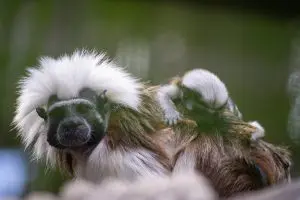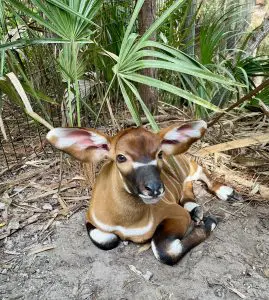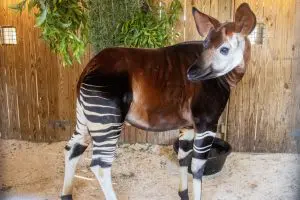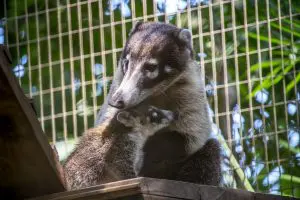

Our Zoo’s cotton-top tamarins are just one of several participants of the AZA Species Survival Plan®!
You may have wondered how and why zoos make decisions when it comes to pairing animals. Well, this can be answered by understanding the role of something called the Species Survival Plan (SSP) program!
What is an SSP program?
The Species Survival Plan is a program managed by the Association of Zoos and Aquariums (AZA) and implemented across AZA-accredited institutions. An SSP’s purpose is to coordinate the pairing of animals to sustain a “genetically diverse, demographically varied and biologically sound population,” according to AZA’s definition.
Why is this important?
“This is how AZA manages genetically diverse populations to ensure that we maintain species and educate the public on conserving wildlife and wild places,” said Lauren Hinson, our director of animal programs. “It can also be used to reintroduce species back into their native range.”
To make sure populations remain diverse, AZA-accredited facilities can use strategies like genetic testing and a database called a studbook which tracks animals’ genealogy.
These plans are especially important for critically endangered species, like our Eastern bongos. With fewer than 200 Eastern bongos left in their natural range in Kenya, every baby bongo birth at a zoo is a step toward safeguarding this species’ population.

This baby is the offspring of Denver and Sebastian, two adult Eastern bongos at our Zoo.
What does it mean to be genetically diverse?
In the context of animal populations in human care, being genetically diverse means maintaining a broad range of genetic variation within a population. This is key when it comes to breeding endangered species where populations in zoos have dwindled, since reduced genetic variation or inbreeding can lead to a number of issues for animals.
The Role of SSP at Our Zoo
To successfully build such a population, animals can be transferred from zoo to zoo when they are deemed a genetic “match.” Though we rely on SSPs to make sure there are viable populations, AZA-accredited organizations rarely take animals from their native ranges. The only exception would be if a species needed to be rebuilt for conservation purposes.
Zoos may also transfer parents’ offspring to other AZA-accredited zoos to allow the pair to continue to reproduce. This was the case for our okapi, George, who was transferred to our Zoo as a part of his SSP last year to allow his mother to potentially breed again.

George came into our care at one year old!
It’s important to note that SSPs are not only used for restoring declining populations, but they also safeguard species, like white-nosed coatis, in their natural range.
Because wild coatis face threats to their population like habitat loss from deforestation and hunting, AZA-accredited facilities aim to establish a healthy population within human care. However, this wasn’t quite as simple as it sounds!
After taking on the role of the studbook keeper for white-nosed coatis in 2018, Lauren Hinson noticed an absence of new coati births in AZA-accredited organizations.
“There had been no births in a long time, and the age distribution was skewed toward older individuals,” Lauren said. “I also received a lot of updates regarding geriatric animal deaths.”
By using in-depth research about the species’ history, looking closer at social dynamics between female and male coatis, and bringing new coatis in from a private facility, our Zoo gathered a “founding” breeding group.
To our luck, we were the first North American AZA-accredited organization in 7 years to successfully breed the animals last spring!
“We managed them as they would be in their natural range, which we think played up to our success,” Lauren said.
The male lived apart from the female-only band until breeding season came along. After breeding, we removed the male since the females no longer tolerated him.
For now, the white-nose coati’s former SSP was downgraded to a studbook-managed program, but the goal is to boost the population in AZA-accredited organizations. Then, they have a chance to regain a signature SSP program, Lauren added.

Our Zoo plans to transfer our grown coatis to other AZA-accredited zoos in hopes that they can successfully breed!
By maintaining genetic diversity and creating opportunities to rebuild critically endangered populations, SSP programs are helping to secure the future of species like cotton-top tamarins, Eastern bongos, coatis and many more. Our Zoo is proud to be a part of this essential work, contributing to the preservation of these incredible animals!
Special thanks to Flammio Financial Group, Stifel-Garvin Wealth Management Group, Artemis IT, and Jim and Darleen Barfield. Their generosity makes our work possible!
Brevard Zoo is an independent, not-for-profit organization that receives no recurring government funding for our operating costs. Your generous support enables us to continue to serve our community and continue our vital animal wellness, education and conservation programs.